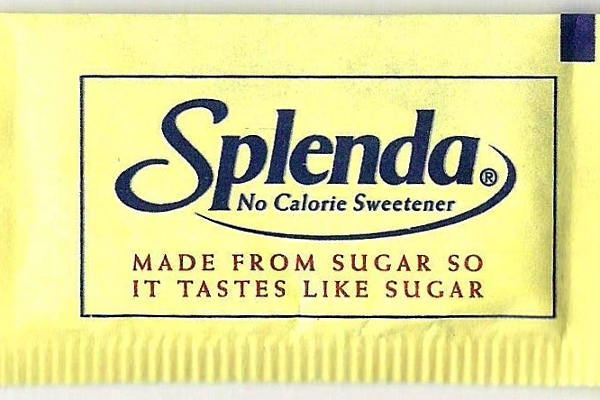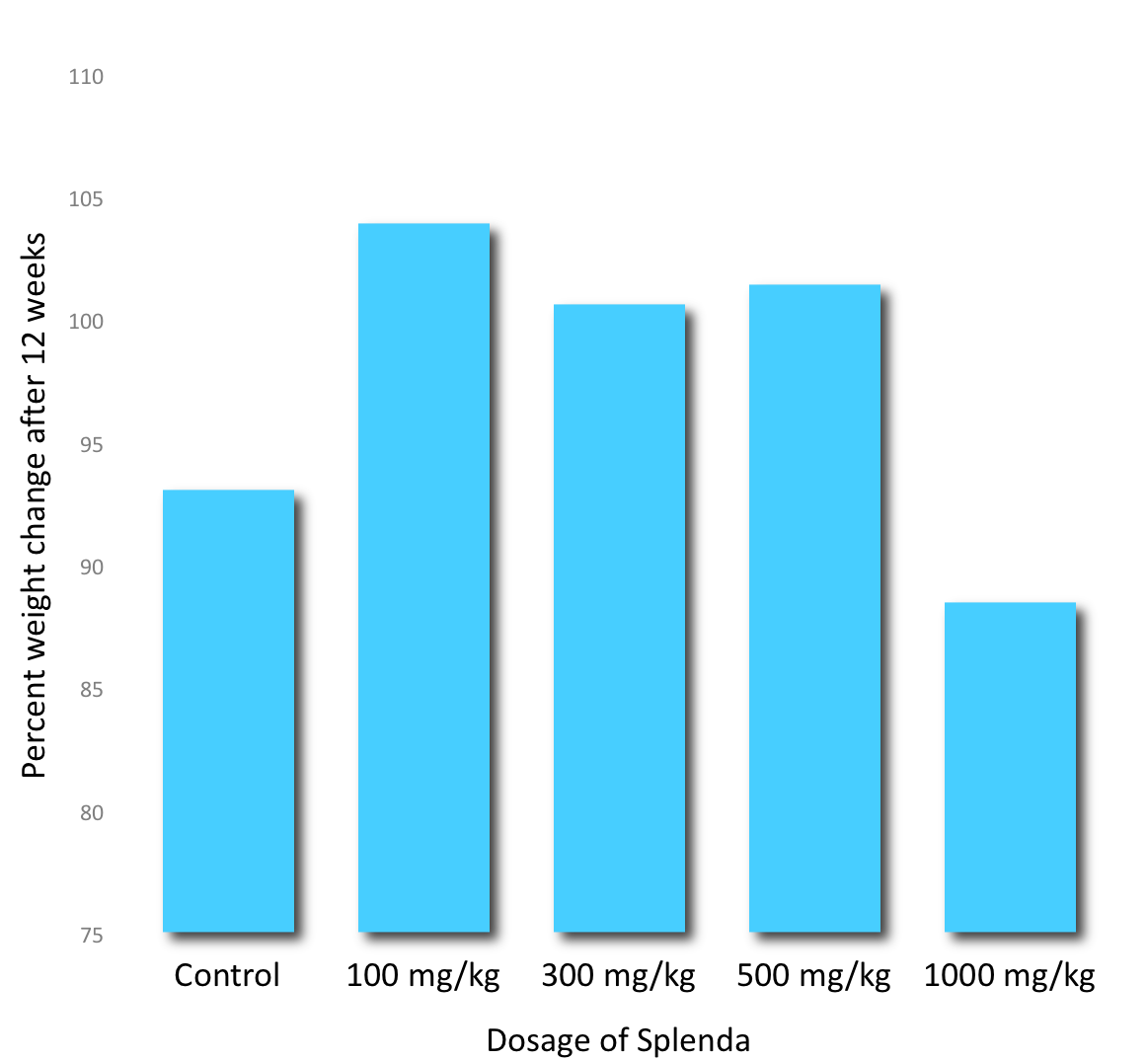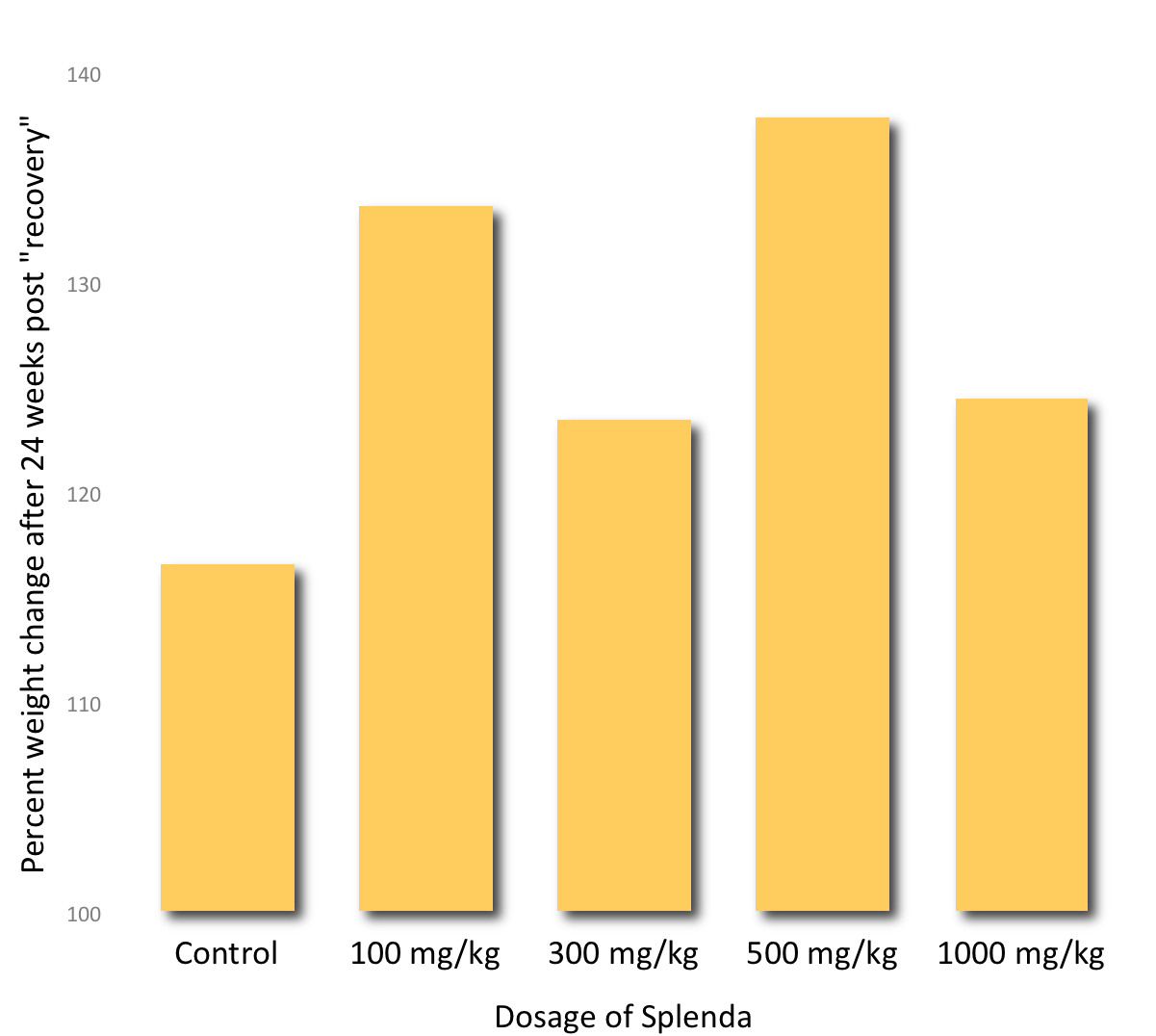Many body-conscious people opt for artificial sweeteners instead of sugar when they want to satisfy their sweet tooth. Splenda is a common choice.
What is Splenda?
It’s a mixture of sucralose (or E955 – named by the European Union) and filler (maltodextose and dexose). Sucralose is a disaccharide (which literally translates to “two sugars”) that is made from sucrose by replacing three hydroxyl (OH – oxygen and hydrogen) groups with chlorine (Cl). (Precision Nutrition members can read more about the various saccharides in All About Carbohydrates.)
That’s how Splenda got their original slogan, “Made from sugar so it tastes like sugar.” However, after getting some flack about misleading consumers, they changed the slogan to “Starts with sugar, tastes like sugar, but is not sugar.” Not sugar… good to know — though 47% of responders to a survey (by Johnson & Johnson, the parent company of Splenda) didn’t know Splenda wasn’t natural.

Sucralose has three advantages over other artificial sweeteners:
- it has virtually no aftertaste
- it’s stable when heated so you can cook and bake with it
- it’s stable at different acidities (pHs) so it can be added to things like lemon juice without affecting its sweetness
In 1998, the FDA approved the use of sucralose. Here’s a quote from the FDA report:
“Using the no-observed-effect level of 500 mg/kg bw/d* and applying a 100-fold safety factor, the agency has determined an ADI (acceptable daily intake) of 5 mg/kg bw/d for sucralose. This ADI estimate is well above the 90th-percentile EDI (expected dietary intake) for sucralose of 1.6 mg/kg bw/d”.[1]
*milligrams per kilogram of body weight per day
Let’s translate that scientific-ese, and use an example of an average person who is 68.2 kg, or 150 lbs.
- 1.6 mg per kilogram of body weight per day (mg/kg bw/d) is what the FDA would expect the most frequent users of sucralose to be consuming (the top 10%)
- For our 68.2 kg person, this works out to 109 mg per day
- 5 mg/kg/bw/d is what the FDA would still consider well inside the safe amount of sucralose to use
- For our 68.2 kg person, this works out to 341 mg per day
How does that translate to sweetness? Well, since sucralose is about 600 times sweeter than sugar:
- 109 mg of sucralose would translate to 65.4 g of sugar (15.9 teaspoons of sugar)
- 341 mg of sucralose would translate to 204.6 g of sugar (48.7 teaspoons of sugar)
Since Splenda is only 1.10% sucralose, to reach the FDA’s ADI of 5 mg/kg bw/d of sucralose you would need to consume 454.5mg/kg/d (or 31 g for our hypothetical person) of Splenda.
The discovery of sucralose –- don’t try this at home
One day in 1976, at his lab in Queen’s College, London, Professor Leslie Hough asked one of his foreign graduate students, Shashikant Phadnis, to “test” a compound in the lab. But poor Phadnis misunderstood, and thought he was suppose to “taste” this compound!
Luckily for Phadnis, the lab wasn’t working with toxins, but halogenated (a specific group in the periodic table that includes chlorine) sugars. So Phadnis tasted (instead of tested) the compound and found it to be incredibly sweet. Instead of having a lawsuit for the death of a grad student, Professor Hough (along with a British sugar company, Tate & Lyle), had a new artificial sweetener -– sucralose.
Fun factoid! The artificial sweetener field seems to be littered with scientists tasting things they shouldn’t. Constantin Fahlberg contaminated his sandwich with saccharin –- a chemical he was working with — which led to him tasting all the chemicals he worked with that day to discover saccharin was really sweet. Jim Schlatter licked his finger one day while working, noticed the sweetness, and went on a chemical tasting tour of his lab to eventually locate the culprit: aspartame.
It’s a bit strange, because every scientist I know (including myself) wouldn’t drink sterile distilled water from a lab. It just doesn’t seem like a good idea. Oh well -– maybe that’s why I haven’t discovered a new artificial sweetener. (Or the cause of ulcers, as researcher Barry Marshall did when he purposely infected himself with Helicobacter pylori bacteria. And I don’t even want to know who found out that diabetics’ urine tastes sweet.)
Research question
Thanks to either the foolishness or bravery of scientists, we have today’s research review study, which examines the safety of Splenda in the gastrointestinal tract of rats.
Abou-Donia MB, El-Masry EM, Abdel-Rahman AA, McLendon RE, Schiffman SS. Splenda alters gut microflora and increases intestinal p-glycoprotein and cytochrome p-450 in male rats. J Toxicol Environ Health A. 2008;71(21):1415-29.
Methods
First, the researchers analyzed Splenda® (“No Calorie Sweetener Granular”), and found it to be 1.10% sucralose, 1.08% glucose, 4.23% moisture and 93.59% maltodextrin. Again, since sucralose is so sweet there isn’t all that much of it in Splenda.
Study subjects
The study participants were male adult rats (Sprague-Dawley). Yes, we all know that rats aren’t people. (Although arguably some people may have ratlike qualities.) But because of ethical reasons you can’t do these kinds of experiments. The biggest ethical reason is that the rats are sacrificed at the end. Ethics boards and the authorities at large frown upon bumping off people, regardless of your reason.
Treatment
For 12 weeks the rats were given various concentrations of Splenda:
- Control: water (0mg/kg/day of sucralose)
- 100 mg/kg/day of Splenda or 1.1 mg/kg/day of sucralose*
- 300 mg/kg/day of Splenda or 3.3 mg/kg/day of sucralose
- 500 mg/kg/day of Splenda or 5.5 mg/kg/day of sucralose**
- 1000 mg/kg/day of Splenda or 11 mg/kg/day of sucralose
*1.6 mg /kg/day is the estimated daily intake (EDI)
**5 mg/kg/day of sucralose is the FDA-established ADI
During the 12 weeks fresh fecal pellets were collected for measuring pH and bacterial levels. Researchers also weighed the rats weekly. After 12 weeks half the rats were sacrificed and the small and large intestine was removed for analysis. The other half of the rats were given water for 12 weeks (called “recovery”) .
Results
Weight gain
Probably the most interesting thing they found was that at the lowest dose, 100mg/kg/day of Splenda (below the expected daily intake), the rats had greater weight gain than the controls (Figure 1). But the higher doses didn’t have greater weight gain -– possibly because of the body’s compensation by increasing the amount of certain proteins to deal with sucralose.
By the way, a previous study showed that there was no difference in food intake between controls and sucralose-treated rats over 26 weeks [2], so increase in food intake is an unlikely cause of weight gain.
Over the entire 24 week period (12 weeks with sucralose + 12 weeks without, aka “recovery”) the rats given 100 mg/kg/day and 500 mg/kg/day had more percent weight gain than the control (Figure 2). But there was no difference at 300 mg/kg/day and 1000 mg/kg/day — which is weird, because you’d expect either that more sucralose would a) increase weight even more, b) plateau or c) show no change. Here we have increasing amounts of sucralose alternating between increasing weight and making no difference. Hmmm. The authors provide no explanation.
There is one possibility that I can come up with: threshold levels of compensation to sucralose. The first threshold is after 100 mg/kg/d but before 300 mg/kg/d –- so you see weight gain at 100 mg/kg/d but not 300 mg/kg/d because of compensation. The second threshold is after 500 mg/kg/d but before 1000 mg/kg/d –- so again you see weight gain before the next level of compensation occurs.


Bacteria
After 12 weeks of Splenda consumption (at all dosages) the rats had less “good” bacteria in their gastrointestinal tracts. In the 100 mg/kg/d dosage (the lowest dosage) the total amount of anaerobes (non oxygen consuming bacteria) was down 49.8%! Even after 12 weeks of “recovery” the bacteria hadn’t returned to normal levels: 100 mg/kg/d dosage still had 53.9% less total anaerobes than the beginning of the experiment.
Important proteins: P-Glycoprotein & Cytochrome P450
The last thing that the researchers looked at was changes in protein after 12 weeks of Splenda and following 12 weeks of “recovery”. The two proteins they looked at were P-glycoprotein and two cytochrome P-450 isoenzymes (enzymes that have different structure but the same or very similar functions.)
P-glycoprotein (p-gp) is an intestinal chemical transporter. In the case of Splenda consumption it turns out that 300mg/kg/day and 500mg/kg/day increases the amount of p-gp, but 1000mg/kg/day results in a decrease. When you have more p-gp you can transport more chemicals. In this case it’s likely that sucralose is being transported -– so what does that mean? It means at 300mg/kg/day and 500mg/kg/day your body tries to clear sucralose out of the gut, but at 1000mg/kg/day another protein comes into play: cytochrome P450.
Cytochrome p450 is a family of proteins. Two that were tested for this study were CYP3A4 and CYP2D1. Don’t worry about what all the letters and numbers stand for –- essentially, the two CYPs are slightly different flavours of the same basic protein. Both are responsible for breaking down foreign toxins (such as drugs) in the intestine and in the liver. For this study researchers just looked at the intestine. Both CYPs (CYP3A4 and CYP2D1) go up at 300mg/kg/day, 500mg/kg/day and 1000mg/kg/day. Each dosage increase leads to more protein.
Since 1000mg/kg/day had the highest CYP amounts the authors thought that were so many CYPs breaking down sucralose (big assumption) that there was no need for more p-gp. That’s why p-gp didn’t go up in the 1000 mg/kg/day Splenda group. CYPs seemed to be handling things.
Conclusion
What does it all mean? Well there are two major points to take home. First, relatively low amounts of Splenda (100mg/kg/day) may cause weight gain. And second, Splenda at moderate levels (300mg/kg/day and up) has adverse effects on your gut, affecting both levels of gut flora and proteins.
Why does this matter? Changes in gut bacteria can lead to problems with your immune system and ability to absorb nutrients. Changes in proteins levels, specifically p-gp and CYP3A4 & CYP2D1, seem to be a good thing -– you get rid of more foreign chemicals. But there are cases when this is bad. Say you’re undergoing some sort of treatment for cancer or are taking anti-depressants. Then your body will remove the drugs you are taking more quickly, making the drugs less useful.
There is a rather simple counterargument to this study: you are not a rat (if you are, e-mail me; I’m sure we both can make a lot of money off a reading rat). So it’s hard to be 100% confident that these results would be the same in people. Hopefully, in the future a similar study will look at sucralose consumption and weight gain in people, although the study would have to be over a year long to translate the 12 rat weeks into people weeks. Anybody interested in signing up for a study that will take more than a year, and may lead to digestive problems and weight gain? Hey, at least you’ll get to eat sweet stuff!
My recommendation: if you have digestive issues or problems losing weight, or if you are taking any type of medication, then stay away from the sucralose and Splenda. Also, if you are pregnant or breast feeding, I’d suggest you steer clear of Splenda as well -– just to be safe. If you don’t fall into any of these categories, then use Splenda (and sucralose) sparingly. By the way, unless you are adding Splenda to your food (and can calculate your intake based on your new knowledge that Splenda is 1.10% sucralose) it’s very difficult to find out how much sucralose is in what you’re eating — good luck trying to find out how much sucralose is in your protein powder!
References
Click here to view the information sources referenced in this article.
Learn more
Want to get in the best shape of your life, and stay that way for good? Check out the following 5-day body transformation courses.
The best part? They're totally free.
To check out the free courses, just click one of the links below.




Share